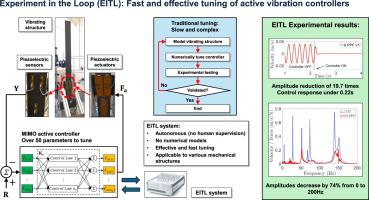用于快速有效调整主动振动控制器的环中实验系统
IF 7.1
1区 工程技术
Q1 ENGINEERING, MECHANICAL
International Journal of Mechanical Sciences
Pub Date : 2024-09-28
DOI:10.1016/j.ijmecsci.2024.109753
引用次数: 0
摘要
调整主动控制器是主动振动控制(AVC)领域的主要挑战之一。为应对这一挑战,本研究引入了一种名为 "环中实验(EITL)"的新方法。与传统技术不同,EITL 方法通过基于粒子群优化(PSO)的算法实现了调谐过程的自动化。该算法对结构进行多次实验测试,每次测试都会尝试新的控制器配置,评估其性能,并迭代改进控制参数。EITL 的创新之处在于无需任何数值模型即可实现快速高效的调整,这使其成为 AVC 技术的一大进步。通过在装有三个压电传感器和三个压电致动器的复合梁上调整五个多输入多输出(MIMO)正位置反馈(PPF)主动振动控制器,对 EITL 方法进行了验证。实验结果表明,复合梁的 "H"∞规范在某些模式下降低了 96.1%,在 0 到 200 Hz 的频率范围内平均降低了 74.7%,溢出效应最小。所开发的 EITL 为无需数值模型就能快速有效地调整 AVC 开辟了途径。本文章由计算机程序翻译,如有差异,请以英文原文为准。

Experiment-in-the-Loop system for fast and effective tuning of active vibration controllers
Tuning active controllers is one of the main challenges in the field of active vibration control (AVC). To address this challenge, this study introduces a novel approach called Experiment in the Loop (EITL). The EITL method, unlike traditional techniques, automates the tuning process through an algorithm based on Particle Swarm Optimization (PSO). This algorithm carries out numerous experimental tests on a structure and, at each test, tries a new configuration of the controller, evaluates its performance, and iteratively improves the control parameters. The EITL's innovation lies in its ability to achieve fast and efficient tuning without any numerical model, making it a significant advancement in AVC technology. The EITL approach is validated by tuning five Multiple-Input Multiple-Output (MIMO) Positive Position Feedback (PPF) active vibration controllers on a composite beam equipped with three piezoelectric sensors and three piezoelectric actuators. Experimental results show that the ‖H‖∞ norm of the composite beam is reduced up to 96.1% on certain modes, and an average reduction of 74.7% is achieved in a frequency range from 0 to 200 Hz with minimal spillover effects. The developed EITL opens the avenue to a fast and effective tuning of AVC without numerical models.
求助全文
通过发布文献求助,成功后即可免费获取论文全文。
去求助
来源期刊

International Journal of Mechanical Sciences
工程技术-工程:机械
CiteScore
12.80
自引率
17.80%
发文量
769
审稿时长
19 days
期刊介绍:
The International Journal of Mechanical Sciences (IJMS) serves as a global platform for the publication and dissemination of original research that contributes to a deeper scientific understanding of the fundamental disciplines within mechanical, civil, and material engineering.
The primary focus of IJMS is to showcase innovative and ground-breaking work that utilizes analytical and computational modeling techniques, such as Finite Element Method (FEM), Boundary Element Method (BEM), and mesh-free methods, among others. These modeling methods are applied to diverse fields including rigid-body mechanics (e.g., dynamics, vibration, stability), structural mechanics, metal forming, advanced materials (e.g., metals, composites, cellular, smart) behavior and applications, impact mechanics, strain localization, and other nonlinear effects (e.g., large deflections, plasticity, fracture).
Additionally, IJMS covers the realms of fluid mechanics (both external and internal flows), tribology, thermodynamics, and materials processing. These subjects collectively form the core of the journal's content.
In summary, IJMS provides a prestigious platform for researchers to present their original contributions, shedding light on analytical and computational modeling methods in various areas of mechanical engineering, as well as exploring the behavior and application of advanced materials, fluid mechanics, thermodynamics, and materials processing.
 求助内容:
求助内容: 应助结果提醒方式:
应助结果提醒方式:


